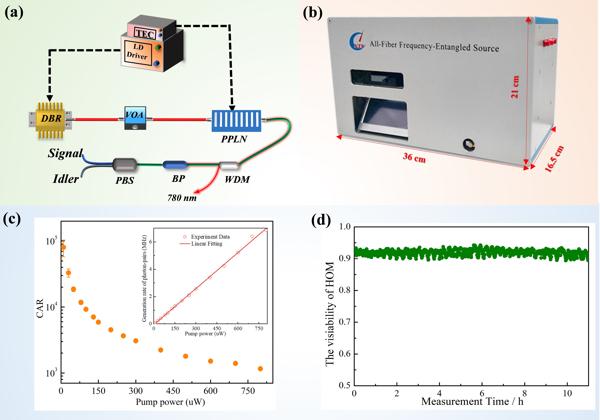Entangled photon pairs are not only a crucial element of quantum networks but also essential resources for quantum information processing systems. As the most common method of generating entangled photon pairs, the spontaneous parametric down-conversion (SPDC) process can provide entanglement in diversified degrees of freedom. Among them, energy–time entanglement has attracted growing attention due to its strong temporal correlation and robustness to loss and decoherence when propagating through long-distance fiber links, and the energy-time entangled biphoton source at the telecom band has been applied as the resource in numerous fiber-based quantum communication and metrology experiments. The productization of the energy-time entangled photon source with high compactness, high stability, and high performance is crucial for extending these quantum information technologies from the proof-of-principle demonstration to realistic applications over long-haul field fiber links or networks.
So far, energy-time entangled photon pair sources based on the continuous-wave (CW) pumped SPDC process have been extensively developed and investigated. However, in addition to the disadvantages of large mass and volume, the previously reported photon pair generation efficiency and long-term stability of entangled sources cannot meet the requirements of field applications.
The research group led by Prof. Dr. Ruifang Dong from the National Time Service Center, Chinese Academy of Sciences reports an all-fiber telecom-band energy-time entangled biphoton source (see Fig. 1),which is published in Chinese Optics Letters, Volume 21, Issue 3, 2023 (Y. Liu, et al., All-fiber telecom-band energy-time entangled biphoton source). For convenience to transport, the overall body weight is reduced to 5 kg with all the physical elements integrated into a cabinet of 36 cm × 21 cm × 16.5 cm. The photon-pair generation efficiency and corresponding purity are investigated as a function of the pump power. At a pump power of 800 μW, the generated photon pairs reach a rate as high as 6.9 MHz with the coincidence to accidental ratio (CAR) better than 1150. By measuring the long-term performances of Hong–Ou–Mandel (HOM) interference visibility and CAR at a pump power of 60 μW, the stability of the biphoton source has also been tested. Within 10 h of continuous operation, the directly measured HOM visibility without any noise subtracting maintains at 91.8 ± 0.8%, and the CAR is consistently at the level of 10,528.8 ± 604.2.

Fig. 1 (a) Schematic diagram and (b) Physical image of the all-fiber telecom-band energy-time entangled biphoton source. Measurement results of (c) the CAR and photon pair generation rate as a function of the pump power, (d) the Hong–Ou–Mandel (HOM) interference visibility in the period of more than 10 h at the pump power of 60 μW.
Prof. Dr. Dong said, such an all-fiber biphoton source has already been successfully applied in their quantum clock synchronization experiments over 100 km urban fiber links, quantum nonlocality tests, and quantum microwave photonics research. Benefiting from the advantages of compact and lightweight designs, simple production, and high stability, this source will provide a convenient and valuable resource for various field turnkey quantum communication and metrology applications.


